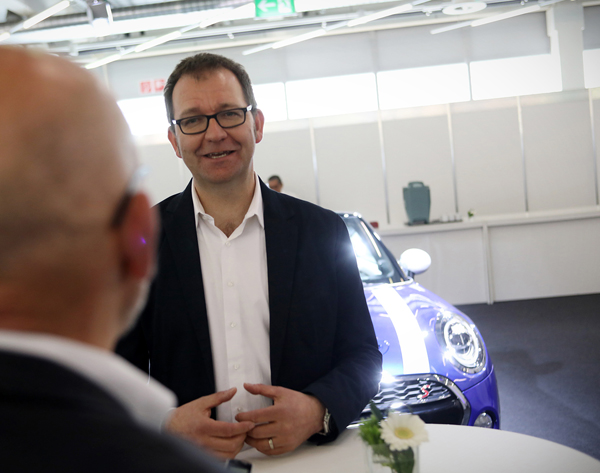
|
|
BMW Group IT wants to become 100 percent agile so that it can implement IT solutions more quickly, extend them more flexibly and generate greater benefits for users. Ralf Waltram who, as VP of the BMW Group, is responsible for IT systems in vehicle development, explains what this means for the carmaker’s future PLM landscape. 
Question: What demands does the BMW Group's digitalization strategy place on the future IT and PLM landscape? Waltram: In 2016, we derived our IT strategy from the BMW Group's corporate strategy NUMBER ONE > NEXT. In doing so, we focused on four core issues: IT in products and services, digitalization of the business processes, customer-centric IT service delivery, and people and culture. Flexibility and speed are particularly vital requirements for customer-centric IT service delivery and we are addressing them with our "100% Agile" initiative. This places a clear focus on agility in software development and a realignment of our structure through DevOps, in which we bring together development and operations in the teams. To become more agile, we also need to design our PLM landscape more flexibly as it is currently still dominated by monolithic solutions. Question: So agility is also driving the transformation of the PLM landscape? Waltram: Absolutely. It’s driving us towards open, flexible solutions with modern GUIs. The whole subject of the user experience plays an important role in this context. We also discuss this aspect with PLM software vendors to ensure that the solutions made available on the market in the future will support a modular, service-oriented approach that offers an optimum user experience. Question: What are the most important components of this service-oriented architecture? Waltram: As part of our iPDM initiative, we’re currently working on replacing our legacy MBOM management system TAIS. In doing this, we are pursuing a "3+1 architecture concept" with a data backbone via which we can integrate the IT systems in our landscape. This data backbone won’t be a monolithic system but rather a lightweight, semantic interface via which data for a range of business processes flows. Question: You’ve chosen PTC Windchill as the successor to TAIS and opted for Aras Innovator for test data management. However, you also use Teamcenter and SAP PLM. How does all this fit into the PLM landscape and what components are still missing? Waltram: We chose PTC Windchill as the successor to TAIS. However, our PDM backbone comprises a lot more than that; for example, it includes in-house developments such as our geometry data management solution PRISMA. We’re currently working on defining what our future backbone and the associated "3+1 architecture" should look like and how it should work. We’re pursuing a "best in class" approach for the various areas and will then link them via the data backbone with the aim of creating a service-oriented architecture that meets the considerable demands we place on the user experience. Question: To do this, you’re using relatively traditional components like Windchill and Teamcenter, which is being considered as the successor to PRISMA. How does that fit in with the flexibility you’re looking for? Waltram: What do you mean by traditional? When it comes to innovation, highly respected market analysts such as Forrester consider vendors such as PTC and Aras, for example, to be drivers of change. Their software solutions make it possible to develop state-of-the-art, service-oriented architectures. No final decision as to what will replace PRISMA and other parts of the landscape has yet been made. At present, we’re concentrating on the topics iPDM and MBOM. Question: What role does Aras play in the context of the "3+1 architecture"? Could Aras Innovator serve as this integration layer in a similar way to that at the automotive industry supplier Schaeffler or are you considering developing a solution in-house? 
Waltram: We’re currently addressing the issue of test data management with the Aras solution, and it would be premature to examine the question of whether it’s also a possible candidate for the data backbone. That is why we haven’t yet addressed the question of middleware developed in-house, even though it would undoubtedly be an exciting topic of interest to our software architects, who have already performed various evaluations and proofs of concept.Question: Will you use new integration concepts like data linking to interconnect the IT systems via the data backbone? Waltram: We are of course giving thought to concepts like that, because it makes no sense to create a monolithic data backbone with just one large database. If we want to remain lightweight, there are a lot of arguments in favor of simply interconnecting the systems and data at the logical level. Question: At the prostep ivip Symposium, BMW Group CIO, Klaus Straub, made a clear commitment to openness. What role do the CPO and CPO certification play in the procurement of new software? Waltram: Openness is an important prerequisite for our future agility. From the very start, the BMW Group has demonstrated its commitment to the CPO both inside and outside the association. Our decisions regarding systems are now consistently taken on this basis, with the result that vendors that support the CPO are better placed. 
Question: What beneficial effects do you expect from the implementation of agile methods and a service-oriented PLM architecture? Waltram: As I said earlier, focus is placed on flexibility and speed, and in this context, priority is given to the benefits for the respective user stories. When it comes to the PLM architecture and IT methods, this means that, thanks to increased flexibility and decoupling, we can bring out significantly more releases with software increments each year, whereas in the past we only managed two large releases per year. For example, in the Teamcenter environment, we will deliver ten new releases this year and this will naturally have corresponding beneficial effects for our internal customers, that is to say the users. Question: One precondition for faster implementation cycles will surely be a higher level of standardization of PLM applications? Waltram: Yes, absolutely. When it comes to customer-centric IT service delivery, we are also addressing the issue of standards, for example STEP AP 242, when designing the PLM architecture. If we use external software in new architectures, we will remain very close to the standard and thereby maintain our release capability. We take decoupling seriously and attempt to standardize wherever standards are possible. Question: In particular with regard to new, service-oriented business models, what is the significance of integrating IoT platforms that bring together different vehicle data? Waltram: As part of our digitalization strategy, we’re constructing an IoT platform. However, that is not within my sphere of responsibility. The stated aim is to connect this platform via our "3+1 architecture" in order to provide not all the data, but the relevant data, in the PLM environment. Mr. Waltram, thank you very much for talking to us. (This interview was conducted by Michael Wendenburg)
About Ralf Waltram Ralf Waltram (born 1969) has worked for the BMW Group since 1996 and has been responsible for IT systems in vehicle development since 2016. Together with his team, he places the emphasis on the possibilities for digitalization in the R&D process by means of an agile collaboration model and a focus on a BizDevOps structure. Prior to this, he managed IT projects, for example in China, in Sales and Marketing and was responsible for line functions. Waltram studied IT at Munich University, where he specialized in computer vision and neural networks. |
|
| © PROSTEP AG | ALL RIGHTS RESERVED | IMPRESSUM | DATENSCHUTZERKLÄRUNG | HIER KÖNNEN SIE DEN NEWSLETTER ABBESTELLEN. |

